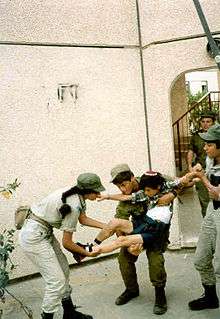Israeli occupation of Sinai
The Israeli occupation of the Sinai Peninsula was a 15-year military occupation established in the aftermath of the 1967 Six-Day War, a war in which Israel captured the peninsula and subsequently retained its forces in the region, and ended in 1982 after the implementation of the 1979 Egypt–Israel Peace Treaty.
A total of 12 Israeli settlements were established along the Gulf of Aqaba and in the northeast portion, just below the Gaza Strip.
The peninsula was returned to Egypt in stages beginning in 1979 as part of the Egypt–Israel Peace Treaty.[1] Israel dismantled eighteen settlements, two air force bases, a naval base, and other installations by 1982, including most oil resources under Israeli control.
History
Israeli forces first seized the Egyptian Sinai during the Suez Crisis of October–November 1956. Under heavy international pressure, Israeli forces withdrew in March 1957, after heavily mapping the territory and placing secret supply caches in preparation for the next war. As part of the conditions for the Israeli withdrawal, the Sinai was demilitarized and the UNEF peacekeeping force was established there to police the border between Israel and Egypt. In May 1967, Egyptian President Gamal Abdel Nasser ordered the withdrawal of this force and moved Egypt's own troops into the area. Israel, believing war to be imminent, ultimately launched a preemptive strike against Egypt, beginning the Six-Day War. Within three days, Israel had occupied most of the Sinai.
Following the Israeli conquest of Sinai, Egypt launched the War of Attrition (1967–1970) aimed at forcing Israel to withdraw from the Sinai. The war saw protracted conflict in the Suez Canal Zone, ranging from limited to large scale combat. Israeli shelling of the cities of Port Said, Ismailia, and Suez on the west bank of the canal, led to high civilian casualties (including the virtual destruction of Suez), and contributed to the flight of 700,000[2] Egyptian internal refugees. Ultimately, the war concluded in 1970 with no change in the front line.[3] On 6 October 1973, Egypt commenced Operation Badr to retake the Sinai, while Syria launched a simultaneous operation to retake the Golan Heights, thereby beginning the Yom Kippur War (known in Egypt and much of Europe as the October War). The canal was reopened in 1975, with President Sadat leading the first convoy through the canal aboard an Egyptian destroyer. In 1979, Egypt and Israel signed a peace treaty in which Israel agreed to withdraw from the entirety of the Sinai Peninsula. Israel subsequently withdrew in several stages, ending on 26 April 1982.[4]
Israeli settlements in Sinai

Israeli settlements in the Sinai were split into two regions: one along the Mediterranean coast, and another along the Gulf of Aqaba.[5] Israel had plans to expand the settlement of Yamit into a city of up to 200,000 residents.[6] The actual population of Yamit never exceeded 3,000.[7] The settlements in the Yamit region were demolished by Israel prior to the withdrawal, but the settlements on the gulf: Ofira (Sharm el-Sheikh), Di Zahav (Dahab), and Neviot (Nuweiba) remained intact, and were further developed by Egypt after the withdrawal.
Yamit region
Gulf region
References
- "Upon completion of the interim withdrawal provided for in Annex I, the parties will establish normal and friendly relations, in accordance with Article III (3)." Frank Thompson (1978). Jimmy Carter. US Government Printing Office. p. 496. ISBN 0-16-058935-5.
- Spencer, Tucker. Encyclopedia or the Arab-Israeli Conflict. p. 175.
- "War of Attrition". Encyclopedia Britannica.
- Shipler, David K.; Times, Special to The New York (1982-04-26). "Israeli Completes Pullout, Leaving Sinai to Egypt". The New York Times. ISSN 0362-4331. Retrieved 2019-06-04.
- Middle East Research and Information Project (MERIP) (1977) MERIP Reports 60, p. 20
- The Arab–Israeli Dilemma (Contemporary Issues in the Middle East), Syracuse University Press; 3rd edition (August, 1985 ISBN 0-8156-2340-2
- Kintera.org—The Giving Communities Archived 2006-03-01 at the Wayback Machine. Theisraelproject.org. Retrieved on 2012-01-15.